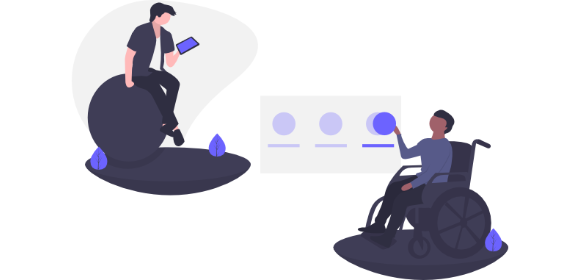How to Make Audio Content More Accessible

How to make audio and video content more accessible
Video and audio are two of the most popular forms of media - from podcasts and social media videos to YouTube tutorials and recorded interviews. For many individuals, audio accessibility features are needed to make these content formats truly usable.
Whether someone is deaf, hard of hearing, or simply has stronger reading comprehension than listening comprehension, accessible features like captions and transcriptions are game-changers.
Let's dive into what audio and video accessibility means, why audiovisual accessibility is important, and what you can do to make your content more inclusive.
Jump to:
What is audio and video accessibility?
Audio and video accessibility is about ensuring that everyone, including people who are deaf or hard of hearing, can engage with your content. This involves adding features like captions for videos and providing written transcripts for audio. These adjustments make your media usable by a wider audience, improving inclusivity and user experience.
Why is video and audio accessibility important?
Making video and audio accessible ensures that a wider audience can engage with your content, including people with hearing impairments. Everyone deserves equal access to digital media, and focusing on accessibility promotes inclusivity.
There are also global standards, like the Web Content Accessibility Guidelines (WCAG) from the World Wide Web Consortium (W3C), which set the global benchmark for web accessibility. These guidelines recommend providing transcripts for all pre-recorded audio and captions for all pre-recorded videos to meet accessibility requirements.
How to make your content more accessible
Here are five ways to make your audio and video content more accessible:
1. Add captions to video content
Captions are essential for making video content accessible, whether it's for social media, training material, or your company's website. Ideally, captions should be synchronized with the audio and users should have the ability to toggle them on or off. By providing this option, you accommodate people who are deaf, hard of hearing, or simply in environments where they can't use sound. You can find captioning standards and guidelines on the W3C website to ensure your captions meet accessibility requirements.
Learn how to add captions to videos with our step-by-step guide.
2. Transcribe audio content
Audio-to-text transcriptions should be shared alongside both audio and video files so that users have all the information needed to understand the content.
You could include basic transcripts - a text version of the spoken content - or descriptive transcripts - which also include a written description of any visual content that might be needed to understand video. Descriptive video transcripts are designed for people who are both deaf and blind.
You could upload these transcripts to your website, and even make them available as a downloadable file.
Discover how to transcribe audio files with our handy guide.
3. Use an accessible media player
A good media player plays a vital role in accessibility. It should be easy to use and allow users to pause, rewind, and fast forward when needed. Users should also be able to adjust the volume, text style, and caption positioning to suit their preferences and to make the experience of watching your video as manageable and enjoyable as possible.
4. Add multi-language support
If your content has a global audience, consider offering multi-language transcripts and captions to accommodate non-native speakers. By providing translations in multiple languages, you demonstrate inclusivity and make your content accessible to a broader demographic.
Find out how to generate multilingual transcripts using our free transcript translation tool.
5. Follow global guidelines
If in doubt, refer to the WCAG to make your content fully compliant with the international accessibility standards.
How making your content more accessible can help your business
Whether you're creating content for your business or a personal podcast, making your audio and video content more accessible can have a range of benefits:
Makes your business more inclusive
Greater inclusivity is ethically important, and it also protects you from legal risks related to discrimination. Inclusivity also boosts customer trust and loyalty, showing that your business values all individuals.
Helps you reach a wider audience
According to the World Health Organization, there are more than 1.5 billion people globally living with hearing loss. This is an enormous population that your business can reach by making your content more accessible. Accessible content also benefits non-native speakers, helping to expand your reach even further.
Ready to make your audio and video content accessible?
Thanks to advancements in AI-powered transcription tools like Transcribe, making your content accessible is easier than ever. Download the Transcribe app or launch the online editor to get started.

How to Transcribe Audio to Text
Wondering how to convert audio into text? From doing it yourself to using the Transcribe app, learn how to transcribe audio with our helpful guide.

How to Compress an Audio File
Need to reduce the size of your audio files before you get them transcribed? Discover the different ways to compress an audio file on Windows, Mac and more.